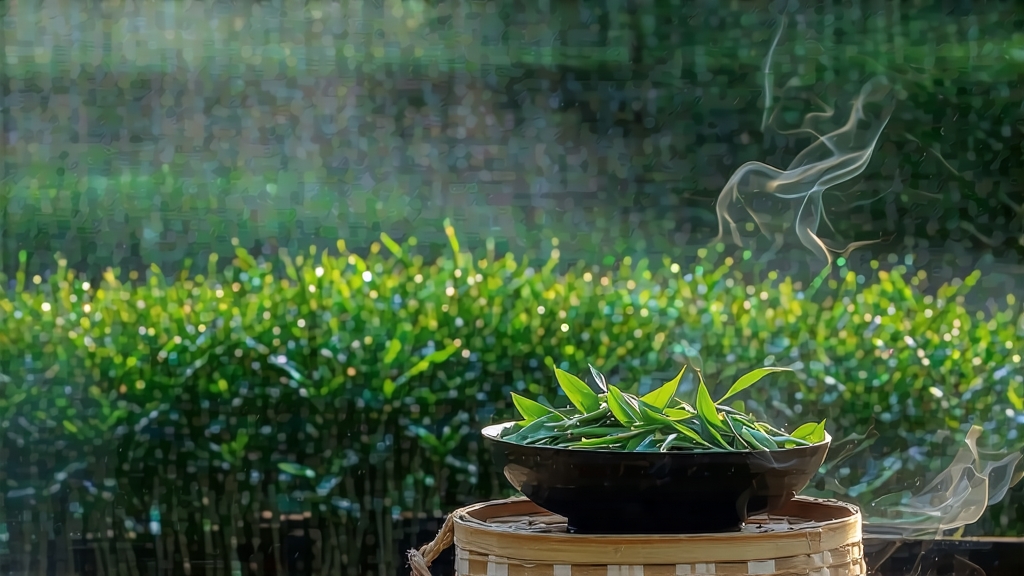
Longjing, literally “Dragon-Well,” is the most celebrated among China’s more than one thousand green-tea varieties. Mentioned in Tang-dynasty poems, canonized by Ming emperors, and served to Nixon during his 1972 visit, this flat, jade-green leaf has become a liquid postcard of Chinese culture. Yet beyond fame lies a subtler story: a tea that encodes the geology of a single limestone basin, the rhythm of the Qingming solar term, and the muscle memory of farmers whose palms have read the same iron wok for five generations.
History: From Buddhist Spring to Global Brand
The earliest written record appears in Lu Yu’s Classic of Tea (760 CE), which lists “Longquan” among the springs that Buddhist monks near Hangzhou used to irrigate terrace gardens. By the Song dynasty the leaves were pressed into dragon-shaped cakes for tribute, but the Ming court’s 1391 ban on compressed tea forced local monks to experiment with loose-leaf drying. They discovered that pressing the still-hot leaf against the wok’s wall created the characteristic sword-shaped flatness and released a nutty fragrance unknown elsewhere. When the Qianlong Emperor visited West Lake in 1751, he planted eighteen bushes by Lion Peak; those same bushes still draw queues of selfie-snapping pilgrims. In 1949 the new government designated Longjing as “China’s Gift Tea,” exporting it to socialist brother nations; today West Lake Longjing fetches over US $2,000 per 500 g at pre-Qingming auctions, while machine-made cousins sell for twenty dollars in supermarkets—proof that terroir and craft still trump geography on the label.
Terroir: Why the Dragon’s Well Matters
The name refers to a 3 m² spring whose dense limestone strata act as a natural filter, yielding water so mineral-balanced that local proverb claims “one dip raises the moon in your cup.” The spring sits at 30°N latitude within a natural amphitheatre of peaks that trap cloud drift, creating 78 % average humidity and filtering sunlight into a soft, diffused glow. Diurnal temperature swings of 8–10 °C slow amino-acid metabolism, concentrating L-theanine and giving the tea its famed sweetness. Only 168 km² enjoy this micro-climate; outside it, the same cultivar produces pleasant but less complex tea. Chinese law therefore registers “West Lake Longjing” as a Protected Geographical Indication, subdivided into five core zones: Lion (Shi), Dragon (Long), Cloud (Yun), Tiger (Hu), and Plum (Mei). Among connoisseurs, Lion Peak offers the most “orchid-chestnut” layer, while Mei Jia Wu tends toward bamboo-shoot freshness.
Cultivars: Beyond the Iconic Shoot
The traditional plant is Longjing #43, a 1960s clonal selection that sprouts seven days earlier than the old seed-grown “group cultivar,” yielding tender, uniform buds ideal for machine shaping. Purists prize the latter—called tu cha or “bush tea”—for its deeper, wilder aroma reminiscent of fennel and wet stone. In the last decade micro-lots of purple-leaf Zijuan and even yellow-leaf Huangjinya have been trialled, adding blackberry and mango top-notes to the classic profile. Yet whatever the cultivar, the picking standard remains ruthless: one unopened bud plus the adjacent leaf, 2.5 cm maximum, plucked before the Qingming festival (around April 5) when night temperatures still dip below 10 °C. After Qingming the same bushes yield yu qian (“before the rain”) tea, still excellent but lacking the icy clarity of the earliest pick.
Craft: Ten Minutes That Decide a Year
Within four hours of plucking, the enzymes must be neutralized to lock in spring’s green. Farmers spread the harvest in bamboo trays for a brief withering—no sun, just ambient air—to shed surface moisture and reduce grassy bite. The decisive act is pan-firing (sha qing) in a hand-forged wok heated to 260 °C. Using only bare palms, the master tosses 250 g of leaves for three minutes, a technique called “grasp, shake, pat, and press.” The motion must be vertical, never circular, to avoid curling the leaf; the sound should resemble raindrops on a lotus leaf. When the leaf temperature drops to 70 °C, the heat is lowered to 80 °C for the h